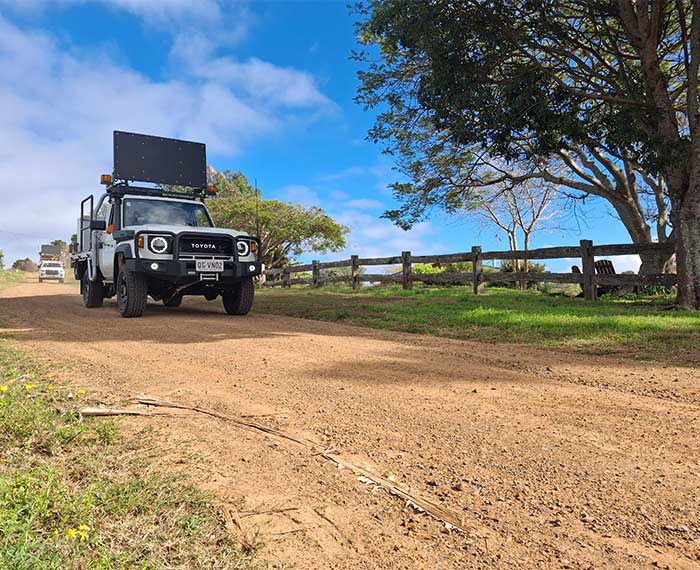878kms of Council roads treated for fire ants

Scenic Rim Regional Council has completed a targeted roadside fire ant treatment program, working alongside the Fire Ant Suppression Taskforce (FAST) to help suppress the spread of one of the world’s most invasive pests.
For around a week and a half in late August and early September, Council teams made use of the FAST blower truck to distribute approximately 1,400 kilograms of Insect Growth Regulator (IGR) bait along 878 kilometres of local roads.
Mayor Tom Sharp said Council’s involvement was part of a coordinated effort with the Queensland Government.
"Roadside treatment is an essential preventative measure," Cr Sharp said.
“These treatments are critical to slowing the spread of fire ants, protecting local ecosystems, and ensuring public safety."
The blower truck – a 4WD utility fitted with a granule spreader – can distribute bait up to 15 metres either side of the road while travelling at speeds of up to 40km/h.
GPS technology is used to track treatment routes.
During this latest program, Council road corridor teams treated non–Department of Transport and Main Roads (TMR) routes in the fire ant suppression zone north of an east–west line running from Canungra through Beaudesert and Boonah.
Roads treated included Brookland Road, Allenview Road, Munbilla Road and Colleyville Road.
This latest work builds on Council’s fire ant suppression activities, which last financial year saw all TMR main roads in the Scenic Rim treated twice as part of a separate program.
Council’s role in this latest program included providing a spotter to record treatment and traffic control where needed, while all other costs – including fuel, bait and vehicle operation – were covered by the state program.
Suburban streets were not treated using the blower truck to avoid bait being deposited on private properties.
Council also ensured treatments were applied in line with safety requirements, avoiding waterways and wetlands where aquatic life could be affected.
The bait is not toxic to pets in the small quantities distributed.
More than 95 per cent of Australia is vulnerable to fire ant infestation.
These small, dark red ants are aggressive, adaptive and capable of inflicting painful stings to people, pets, wildlife and livestock.
Left unmanaged, they can render areas unusable for farming, recreation and everyday living.
Research by the Invasive Species Council has estimated that, if allowed to spread, fire ants could cost Queensland households $188 million annually, excluding any government agriculture sector spending.
Under the Biosecurity Act 2014, everyone is responsible for reporting and managing fire ant nests on their properties and members of the community are urged to report any suspected sightings within 24 hours to the Department of Agriculture and Fisheries on 132 ANT (13 22 68).
More information about fire ants and treatment efforts is available at https://invasives.org.au/blog/8-facts-every-australian-should-know-about-fire-ants/.
